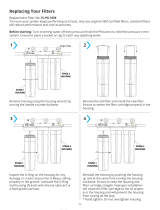
1
Table of Contents:
Safety Precautions:
Conditions for Operation:
• You must follow the guidelines to install this system. Check with your Province/State and
local public works department for plumbing and sanitation codes.
• If house water line pressure is over the maximum 100 psi (pounds per square inch), install a
pressure regulator in the water supply line before this system.
• System is for cold water use only and must be protected against freezing, which can
cause water leakage.
• Don’t use with the water that is microbiologically unsafe or of unknown quality without
adequate disinfection before or after the system. System certified for cyst reduction may
be used on disinfected water that may contain filterable cysts.
• Make sure the water supply conforms to the specification guidelines. If the water supply
conditions are unknown, consult your local municipal water company or health
department about the quality and the list of contaminants of the water in your area.
• CAUTION: When using the system for the first time or after replacing the membrane, the
system should be purged for 24 hours.
Supply Water Pressure Limits ........................................ 40 - 100 psi (276-689 kPa)
Supply Water Temperature Limits ............................... 40 - 113°F (4.4 -45°C)
Maximum Water pH Limits ........................................... 4-10
Maximum Total Dissolved Solids (TDS) ........................ 2,000 ppm
Maximum Water Hardness at 6.9 pH ......................... 10 gpg
Maximum Iron / Manganese / Hydrogen Sulde ..... 0.2/0/0 mg/L
Maximum Chlorine in Supply Water ........................... 2.0 ppm
Automatic shutoff control ........................................... Yes
Safety Precautions ........................................................... 1
Conditions for Operation ................................................. 1
Package Contents ............................................................ 2
Tools Required for Installation ......................................... 2
System Layout and Components ............................... 3 - 4
Installation Instructions ............................................... 5 - 12
* Tapping into Cold Water Line ....................................... 5
* Drilling the Faucet Hole ............................................. 5 - 6
* Installing the Air-Gap Faucet ................................... 6 - 7
* Installing the Saddle Drain Clamp ........................... 7 - 8
* Installing the Membrane Into Its Housing ..................... 8
* Installing the Filter Cartridges and Filter Housing Assembly .. 9
* Mounting RO Unit Under Sink ...................................... 10
* Mounting the Ball Valve Onto Storage Tank ............. 10
* Connecting the Water Lines ....................................... 11
* Tubing Connection with Push-in Fitting ...................... 11
* Icemaker Hook-up (Optional) ..................................... 11
Start-up Instructions ......................................................... 12
6 Month System Maintenance ............................... 12 - 13
Annual System Maintenance ........................................ 14
RO membrane Replacement ....................................... 15
Post Carbon Filter Replacement (VRO-4U only) ... 15 - 16
Check Air Pressure in Storage Tank ............................... 16
Troubleshooting Guide for RO Systems ......................... 17
Performance Data ................................................... 18 - 19
Replacement Parts List ............................................ 20 - 21
Warranty ........................................................................... 22

























